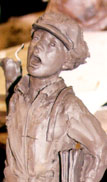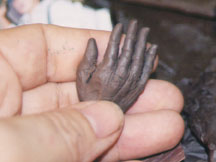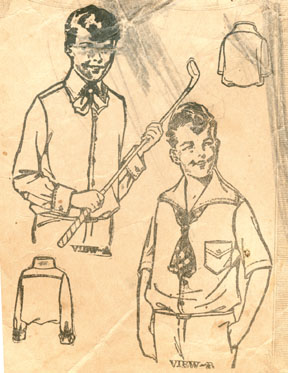Newsboy-A Pattern For Knickers!

September 18-26
Sculptor Bridgette Mongeon has documented the entire process of creating a figurine of a newsboy and a life-size bronze sculpture. Watch the artist work through these posts. In this blog, she has also included information for students and teachers. In the previous post the artist talked about More Research on Clothes and the Sculpting of the Newsboy.
If you are lost and want to go back to the chronological running list of posts, follow this link.
ARTICLES
I was thrilled to receive the two articles printed by the Texas Press Association, this week. The article printed in the Messenger titled EXTRA! EXTRA! TPA revives newsboy in commemorative statue and Texas Press Association’s presidents’ column Newsboy sculpture celebrates our history.

PRICES ON SCULPTURES
This newsboy sculpture will be made into a limited edition bronze in both a small tabletop size edition of 100 and a life size edition of 15. The cost of the life-size Newsboy is *$20,000. There is an additional fee of $2,000 if you desire the bronze newspaper to reflect your newspaper’s history. A small newsboy is also available making a great gift for anyone in the newspaper industry. It is a limited edition of 100. The size of the bronze is approximately 12” tall mounted on a 2” wooden base with brass plaque. The cost of the small bronze newsboy is $1,350. Contact the artist if you are interested.

SCULPTURE PROGRESS
I have made quite a bit of progress on the small sculpture. And I am so happy with how it is coming. It is more than just how it looks, it is how it feels. The sculpture feels good and somehow that comes across to others. This element of sculpting cannot be taught. I am not even sure how to bring this element into a sculpture. It seems that sometimes it happens and sometimes it does not. I am sure it has a great deal to do with how I feel while I am sculpting and the passion for the piece. This sculpture has much going for it in both areas.

I was sad to put it away for a few days, but I am running out of things to do without my reference photos. This week I was able to finish Dusty’s face. I also cut out and sculpted some miniature newspapers.
Then I roughed in Dusty’s hands. To determine the size of a hand, I used the face that I sculpted. A hand is usually the size of the face. If you put the base of the palm of your hand against your chin, most likely your middle finger will meet your hairline. Artists use these type of measurements all the time, when sculpting, painting or drawing.
I was more than anxious to hear from Vintage Pattern Lending Library and I finally did on Thursday evening. They sent me the photos shown below. The shirt and knickers are patterns from the 1920’s. Unfortunately the patterns are in size 8, so there will be some adjusting. Vintage Pattern Lending Library can enlarge the patterns for me but I would have to wait until October 1 to receive them. My schedule with Texas Press Association would allow for this, but I cannot bear to be away from the newsboy for that long. I have requested they send me the patterns and I will see what I can do. I guess I’ll be pulling out my sewing machine next week.
Let’s move on with this project. In the next post we will learn a little bit about The Creative Process.
STUDENTS AND TEACHERS
Art
As mentioned above, artists use all sorts of measurements in their drawing, painting and sculpting. Here are a few that you can try yourself.
• Your eyes are in the middle of your head. Take a pencil and measure from your chin to your eyes, then take that measurement and compare it from your eyes to the top of your head. This is a good thing to remember when drawing a face and it is regular error that beginning drawing students make.
• This measurement shows the placement of the ear. Take a measurement from your chin to your eyes, yes the same measurement as above, but this time turn your pencil horizontally. The distance from the corner of your eye and the back of your ear should be the same as from your chin to the eye in the front. Isn’t that cool!
• A perfectly proportioned adult person is 8 1/2 heads high. Artist use the “head” measurement often. Use the illustration of the boy with the suit, the one facing you. Put your pencil lead tip at the top of his head and drop your thumb down to his chin. Now you have the size of his head. Keep moving that measurement down the boy until you find how many heads high he is. Measure yourself, your parents, your siblings how many heads high are they?
• Have you ever seen an artist with their hand out straight and one eye closed, maybe in a movie or something? They are measuring. You can do this as well. Take your pencil, as in the measuring step above, put the point of it at the top of something that you want to measure. Let’s say your doghouse in the distance. Now slowly move your thumb down to the bottom of the doghouse. What you have now is the size of your doghouse. The tip of your pencil, is the top of the dog house and your thumb is the bottom. “So, what good is that?” you ask. Well… don’t move your thumb, but take your pencil over to your own house. Just like measuring how many heads high the boy on this page is, you can measure how many doghouses will fit in the height of your own house. This measuring tool helps artist to be sure they have things in proportion. If you have already drawn the doghouse, you can now draw your own house and be pretty sure that you have it in proportion to everything else. Just like when I sculpt, it is all about comparisons, comparing the doghouse to the big house. Or, in the case of my sculpture, comparing one photo from one angle with the sculpture to another photo from another angle with the sculpture. With the measuring trick that I have just mentioned, you must not bend your elbow otherwise you will change your measurement. Keep your arm straight and look through one eye. All you need now is a canvas and paint and people will look at you and say, “My, they are a master artist!”
